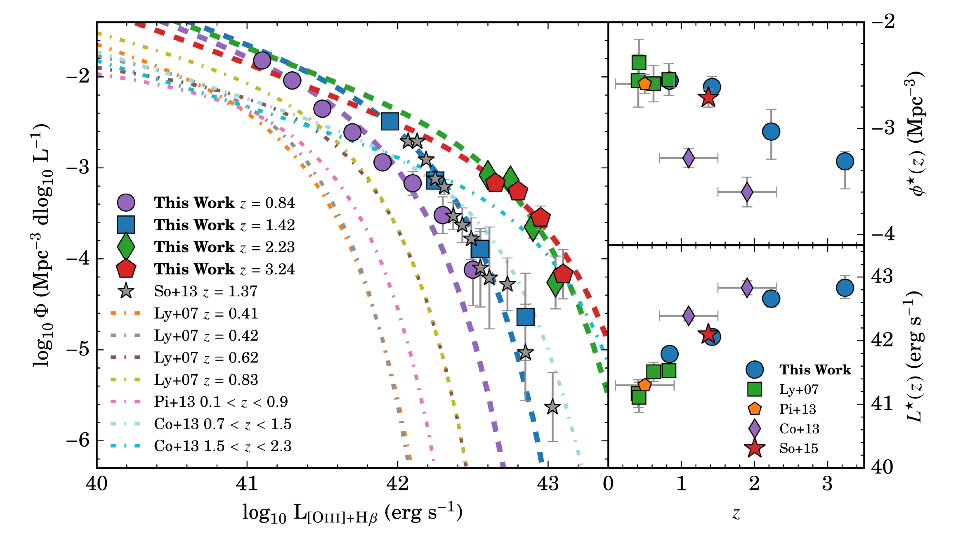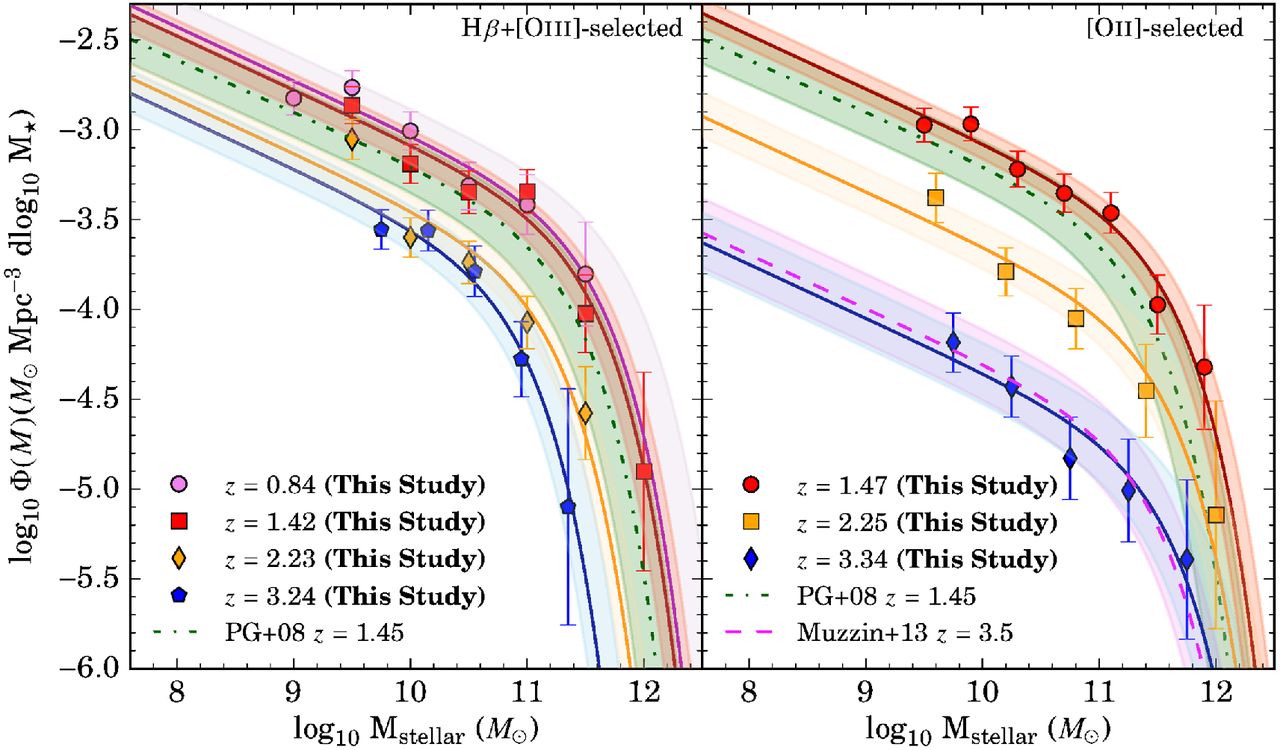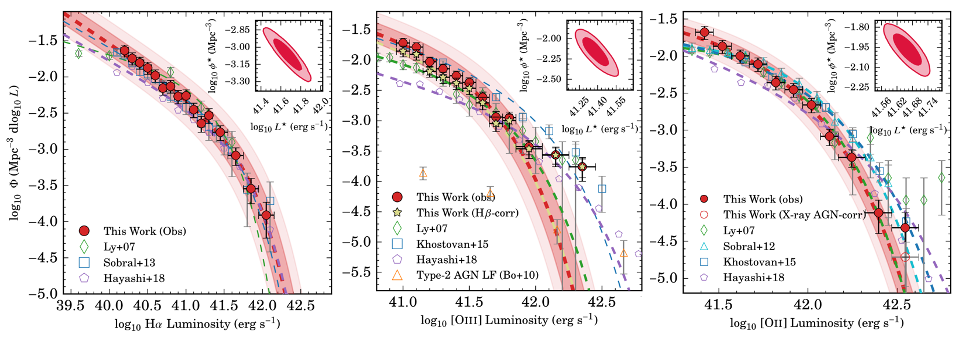Emission Line Luminosity and Stellar Mass Functions up to z ~ 5
Research | | Links: HiZELS Catalog | HiZELS LF | HiZELS SMF | LAGER LF

[OIII]+Hβ luminosity function from \(z \sim 0.8\) to \(\sim 3.2\) from the narrowband HiZELS survey Khostovan 2015. The constraints on the luminosity function shows how such emitters become brighter by a factor of \(\sim 10\) from low-\(z\) to high-\(z\).
I led several studies investigating the key statistical properties of Hα, [OIII], and [OII] emission line galaxies from \(z \sim 0.4\) up to \(z \sim 5\) using wide narrowband surveys observing two extensively studied extragalactic fields: COSMOS and UDS (SXDS). This started with my first paper where I selected, at the time, the largest samples of [OIII] and [OII] emitters from HiZELS which consisted of 4 narrowband filters: 1 on Subaru/SuprimeCam and 3 on UKIRT/WFCAM. The results of this study are shown in the main image above where the luminosity functions are constrained towards high-\(z\), which was uncharted territory at the time.
One key result from this work was the strong evolution in both [OIII] and [OII] luminosity functions where we foound a factor \(\sim 10\) increase in the typical brightness of [OIII] emitters over \(\sim 5\) Gyr of cosmic time. However, [OII] luminosity functions show a significant drop in number densities on the order of \(\sim 30\) times decrease with a steep drop occuring at \(z > 3.3\) suggesting a significant shift in [OII] line production. In comparison, [OIII] number densities decreased by a factor of \(\sim 6\). This is most likely tied into the ISM conditions changing within star-forming galaxies where typical [OIII]/[OII] line ratios are increasing with increasing redshift. Causes for this is probably a mix of harder ionizing radiation spectrum (e.g., intense star formation) and lower metallicities enhancing [OIII] emission.
 The stellar mass functions of [OIII] and [OII] emitters from \(z \sim 0.8\) to \(z \sim 3.3\) as presented in Khostovan et al. (2016).[OIII] emitters are found to have a slow evolution with increasing redshift moving towards lower number densities and stellar masses while [OII] emitters show a significant drop in number densities.
The stellar mass functions of [OIII] and [OII] emitters from \(z \sim 0.8\) to \(z \sim 3.3\) as presented in Khostovan et al. (2016).[OIII] emitters are found to have a slow evolution with increasing redshift moving towards lower number densities and stellar masses while [OII] emitters show a significant drop in number densities.
I also led a study on the stellar mass functions of [OIII], and [OII] emitters from HiZELS in my second paper where SED fitting was done using MAGPHYS. The stellar mass functions highlight how [OIII] emitters show a minor evolution towards lower number densities and stellar masses. On the other hand, [OII] emitters do not show much evolution in \(M^\star\) (typical stellar mass) but rather show a significant drop in number densities by a factor of \(\sim 20\). This would suggest that [OII] emission up to \(z \sim 3\) is typically found in higher mass galaxies possibly those that have already finished a burst of star-formation (e.g., post-starbursts/quenching) while [OIII] emitters are mostly found in low-mass galaxies. This falls in line with recent research that are finding strong [OIII] emission in high-\(z\) bursty star-forming galaxies with JWST while [OII] is significantly weak.
 The Hα, [OIII], and [OII] luminosity functions from the narrowband DECam/NB964 LAGER survey. The data only covers a single 3 deg\(^2\) DECam pointing in COSMOS with a total ELG sample of 10977 emitters; however, when complete, LAGER will cover a 24 deg\(^2\) area with potentially \(\sim 95000\) foreground ELGs (excluding Lyα).
The Hα, [OIII], and [OII] luminosity functions from the narrowband DECam/NB964 LAGER survey. The data only covers a single 3 deg\(^2\) DECam pointing in COSMOS with a total ELG sample of 10977 emitters; however, when complete, LAGER will cover a 24 deg\(^2\) area with potentially \(\sim 95000\) foreground ELGs (excluding Lyα).
Lastly, I led a study using the wide and deep narrowband LAGER survey which consists of a single NB964 filter mounted on CTIO/DECam to select populations of Hα, [OIII], and [OII] at \(z = 0.47\), \(0.93\), and \(1.59\), respectively. The samples were used to place some of the tightest constraints on the associated luminosity functions (see figure above). The unique aspect of LAGER is the fact it is both wide and deep. The wide aspect allows for robust and tight constraints on the bright-end of the luminosity function while the deep aspect allows for constraints on the faint-end slope. One interesting feature from the [OIII] LF is the excess occuring at bright line luminosities. This is primarily attributed to AGN activity powering the emission lines. We can see a similar effect in the bright-end of the [OII] LF where we see an excess that is removed when cleaning the sample of X-ray detected AGNs. Unfortunately, the [OIII] sample did not have many Chandra and XMM X-ray detections, but that could potentially mean these are not X-ray AGNs and rather optical/near-IR AGNs.
